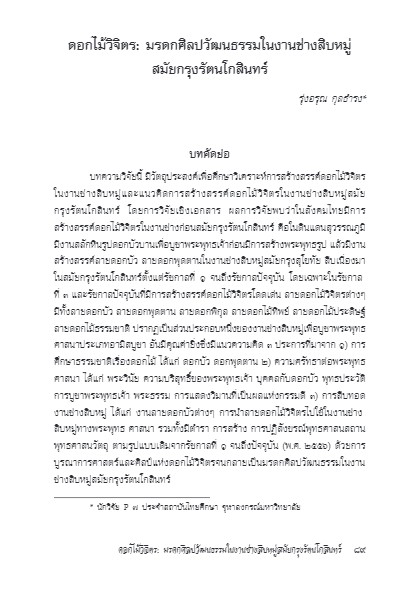รุ่งอรุณ กุลธำรง
บทคัดย่อ
บทความวิจัยนี้ มีวัตถุประสงค์เพื่อศึกษาวิเคราะห์การสร้างสรรค์ดอกไม้วิจิตรในงานช่างสิบหมู่ และแนวคิดการสร้างสรรค์ดอกไม้วิจิตรในงานช่างสิบหมู่สมัยกรุงรัตนโกสินทร์ โดยการวิจัยเชิงเอกสาร ผลการวิจัยพบว่าในสังคมไทยมีการสร้างสรรค์ดอกไม้วิจิตรในงานช่างก่อนสมัยกรุงรัตนโกสินทร์ คือในดินแดนสุวรรณภูมิมีงานสลักหินรูปดอกบัวบานเพื่อบูชาพระพุทธเจ้าก่อนมีการสร้างพระพุทธรูป แล้วมีงาน สร้างสรรค์ลายดอกบัว ลายดอกพุดตานในงานช่างสิบหมู่สมัยกรุงสุโขทัย สืบเนื่องมาในสมัยกรุงรัตนโกสินทร์ตั้งแต่รัชกาลที่ 1 จนถึงรัชกาลปัจจุบัน โดยเฉพาะในรัชกาลที่ 3 และรัชกาลปัจจุบันที่มีการสร้างสรรค์ดอกไม้วิจิตรโดดเด่น ลายดอกไม้วิจิตรต่างๆ มีทั้งลายดอกบัว ลายดอกพุดตาน ลายดอกพิกุล ลายดอกไม้ทิพย์ ลายดอกไม้ประดิษฐ์ ลายดอกไม้ธรรมชาติ ปรากฏเป็นส่วนประกอบหนึ่งของงานช่างสิบหมู่เพื่อบูชาพระพุทธศาสนาประเภทอามิสบูชา อันมีคุณค่ายิ่งซึ่งมีแนวความคิด 3 ประการที่มาจาก 1) การศึกษาธรรมชาติเรื่องดอกไม้ ได้แก่ ดอกบัว ดอกพุดตาน 2) ความศรัทธาต่อพระพุทธศาสนา ได้แก่ พระวินัย ความบริสุทธิ์ของพระพุทธเจ้า บุคคลกับดอกบัว พุทธประวัติ การบูชาพระพุทธเจ้า พระธรรม การแสดงวิมานที่เป็นผลแห่งกรรมดี 3) การสืบทอดงานช่างสิบหมู่ ได้แก่ งานลายดอกบัวต่างๆ การนำลายดอกไม้วิจิตรไปใช้ในงานช่างสิบหมู่ทางพระพุทธ ศาสนา รวมทั้งมีตำรา การสร้าง การปฏิสังขรณ์พุทธศาสนสถาน พุทธศาสนวัตถุ ตามรูปแบบเดิมจากรัชกาลที่ 1 จนถึงปัจจุบัน (พ.ศ. 2556) ด้วยการ บูรณาการศาสตร์และศิลป์แห่งดอกไม้วิจิตรจนกลายเป็นมรดกศิลปวัฒนธรรมในงานช่างสิบหมู่สมัยกรุงรัตนโกสินทร์
(ตีพิมพ์ใน วารสารไทยศึกษา ปีที่ 10 ฉบับที่ 1 (กุมภาพันธ์ – กรกฎาคม 2557) หน้า 89-126)
The Exquisite Flower Pattern: The Artistic and Cultural Legacy of the Ten Thai Arts and Crafts of the Rattanakosin Era
Rungaroon Kulthamrong
Abstract
This article, based on the documentary research, aims to analyze the creation of the exquisite flower pattern of the Ten Thai Arts and Crafts during the Rattanakosin period. The study has found that this Thai artistic floral pattern has been used in arts and crafts long time before the Rattanakosin Era. Moreover, the stonework in the form of lotus flower had been widely used in the Land of Gold, or the Suwannabhumi, as a symbol to worship before the image of the Buddha had been created. Also the design of the lotus pattern, as well as the Hibiscus one, had been passed by the Ten Thai Arts and Crafts group from the Sukhothai period to the Rattanakosin. The design of this exquisite floral shape pattern has been developed especially during the reign of King Rama III and King Rama IX (the present one). All the flower patterns such as the lotus, the Hibiscus (cotton rose), the genus Dalbergia (bullet wood), the Montarop (flower of paradise), either the elaborated flowers or the natural ones are found in the creative works of the Thai artists and craftsmen as a part of their valuable offering to Buddhism (Amisa Puja).
There are three ideas that influence the works of these beautiful flower patterns: 1) the study of flowers in nature such as the lotus and the cotton rose 2) the faith in Buddhism, for example, the Buddhist canons, the purity of Lord Buddha, the symbol of lotus and mankind, the legend of Buddha, Buddhist offerings, Dharma, and the image of Buddhist paradise (Swarga) 3) the continuance of the Ten Thai Arts and Craftwork such as the works with lotus design, etc.
With the willing to integrate the knowledge about the arts of this exquisite flower pattern of the Ten Thai Arts and Crafts through textbooks, architecture and restoration of the Buddhist places and objects as the original one from the reign of King Rama I until now (2015), these beautified arts then become the artistic and cultural legacy of the Rattanakosin era.
(Published in Journal of Thai Studies Volume 10 Number 1 (February – July 2014) Page 89-126)
บทความ / Full Text : Download
